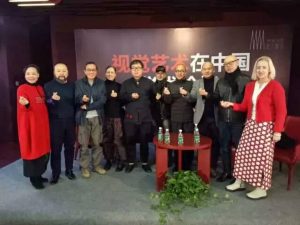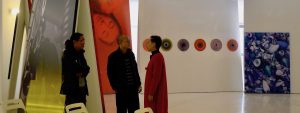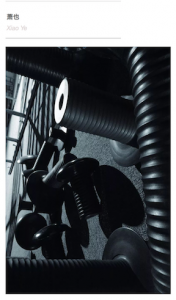Currently showing in the Exhibition “Chinese and International Visual Arts Exhibition Henan” Changsha at the Mezzi bookstore complex, curated by Ma Yiying.
Participating Artists:
Cang Xin, Li Guangbo, Li Wei , Shen Jingdong, Tie Xin , Wang Guofeng, Wu Di, Xiao Ye, Zhang Zhan, and Zhu Zhigang. From the international side Denise Keele-Bedford(Australia, Girar Bourriau (France), Carlo Bernardini (Italy), Claudio Pieronni (Italy) , Leonida De Filippi (Italy), Leonardo Cevallos (Ecuador) , Monica Lin (USA), Niamh Cunningham (Ireland) Sigurdur Gudmundsson (Iceland) and Stevens Vaughn
I was thrilled to meet several of these impressive artists at the opening recently and this blog will take a brief look at some of the artworks and a line or two about what the artist says.
 Wu Xiaobin, Cang Xin, Zhu Zhigang, Monika Lin, WuDi , Li Wei, Ma YiYing, Tie Xin, Wang Guofeng
Wu Xiaobin, Cang Xin, Zhu Zhigang, Monika Lin, WuDi , Li Wei, Ma YiYing, Tie Xin, Wang Guofeng
Zhu Zhigang with curator Ma Yiying and Art and Culture director Wu Xiaobin
“We live in a global village” said curator Ma Yiying “This is an intuitive response as we measure and assess space and distance in a world running at high speed. The cultural integration and exchange of ideas and concepts has all been enabled by the invention of the internet.”
Li Wei, 李暐
Born in Hubei currently working in Beijing, Li Wei’s art practice spans performance, digital media and sculpture. His ‘Li Wei Falls into …’ series create gravity defying situations often using mirrors, metal wires , scaffolding and acrobatics. Mirrors feature prominently in his work , where it has the symbolic meaning as an indicator of truth.
Some of his Fall art works are showing at the Changsha exhibition but also this Buddhist mirrorscape
The artist says :
“The body , all manner of things and the imagination, the world is represented by these three things together …. the freedom and harmony of this trinity.”
Tie Xin ,铁心
Tie Xin merges abstract elements with social existence and deals with the acknowledgment of excessive consumption and vanishing resources. Piles of wasted bulbs in all shapes, sizes and colour reveal the surface aftermath of our glitzy existence and super consumption and contradictions.
The artist says :
“You can’t just separate visual art into Chinese and foreign sections as it functions as one of the best means of communication. In dealing with what is good visual art, there needs to be a wide-ranging renewal and promotion of Chinese understanding of contemporary visual art.”
Xiao Ye, 萧也
Abstract artist Xiao Ye’s practice of the abstract is a spiritual manifestion . . Currently working in Changsha, he majored in ornamental sculpture at the academy of Arts and Design at Tsinghua University . There are two very different works shown side by side : an abstract ink wash abstract and a large digital print both monochromatic and focused on the contradictions of surface and internal forces.
The artist says:
“Infiltrating rice paper and water in Chinese spiritual philosophy means to infiltrate ink and rice paper so that the three(water , ink and paper) are integrated with each other . The endless changes in the collision and mutual attraction deduce internal and external eternity”
Zhang Zhan,张展
Zhang Zhang currently works between Rome and Wuhan and has organized many international and local art exhibitions. He studied at China Central Academy of Fine Art Oil Painting. He is the founder of Chushang art space.
The artist says:
“All waste products emit their natural beauty and even though it might be incomprehensible a special quality exists amidst this refuse.”
Zhu Zhigang,、朱志刚
Zhu Zhigangs cool shades of grey purple and blue are arranged in a huge bank leaving a calming surface of muted geometric grids. It would be hard not to see them as indecipherable pixelated compositions in our contemporary age , a conversation between a more traditional media of brush and paint and digital media.
The artist says :
“The theme of the square grid is appropriated from the mosaic pattern in film and television images such as when the publisher protects the privacy of individuals, the original image of the person is intervened with and replaced with a mosaic” said abstract painter Zhu Zhigang. “However the other side to this is people want to see the real image behind the mosaic. In the various events we confront with in real life many truths are deliberately hidden. That’s probably what I’m trying to do with this stuff.”
Leonardo Cevallos (Ecuador)路易
Leonardo Cevallos came to China in 1995 and studied Lithography and later Chinese Woodcut at the Central Academy of Fine Arts Beijing where he received a Masters degree.
The artist says:
“Global Military conflict not only has devastating effects on individual people but has a multitude of hidden opaque results such as economic, geopolitical, cultural and environmental interventions. Such conflicts are more often presented to a public with a thesis of self-defense against a nuclear war or such threat that would inevitably lead to regional destruction. These stories have led to disastrous conflicts and war.”However environmental damage is our lasting legacy more so than any other. Global business and governments continue to facilitate the incessant use of fossil fuels without regulation. They ignore or worse still claim false the damage we cause our planet .They contribute fiscal and political power to interfere with the prevention of global warming measures. Placing short term economic gain above what we leave behind as legacy to our children, the result of this is The Disloyal Man where no one gains .
Monica Lin (USA),
Monica Lin’s work focuses on the social constructs within society which have ulterior functions . She questions our current notions of beauty, age, material value, commodity and desire.
The fairy tale and its definition of beauty and the myth of its social necessity produce stereo typical images of impossible physical and behavioural standards serving to reinforce dominant culture constructs.
The artist says
Philosopher’s Wall interrogates these cultural constructs and their lasting effects through the juxtaposition of materials, animal/human forms, labor and economics, and aspects of Beauty. Through the use of fairytales in marketing, capitalist interests have created a cycle of consumerism, resulting in prescribed behaviors, social systems, hierarchies and ultimately both psychological and ecological pollution. This glowing, gilded wall, with its 1000 inset gilded walnut shells peopled with plastic and clay, uses the fairy tale motif to situate questions about how distance creates relational perception and preconceived notions of artistic value. From a distance the wall shimmers and glows, beckons and firmly establishes itself in the realm of the valued and desired, the realm of a prescribed Beauty. Upon closer inspection, however, the wall deconstructs itself as wearing lowly materials and disturbing figures emerge.
Wang GuoFeng王国锋
Wang Guo Feng born in Liaoning and working in Beijing, the recipient of national and international photographic awards . His Pixel series are huge blocks of unreadable colour until the viewer decides to walk away and turn around for a quick glance to obtain a hint of an image. Critic Gu Zheng when writing on the artist suggested the Pixel as a unit of history where pixel controlled precision determines the truth of history.
The artist says :
Photos are pixelated and distributed to the public via the Internet in the digital age. I select these media photos and enlarge them to the extreme to make the “pixel”, the fundamental picture elements, to be visualized. The details and the implications of the original photo are lost and transformed to a pure visual image of colorful square. The original myth is subverted and reconstructed.
Cang Xin
Performance artist Cang Xin (Manchu) currently works in Beijing. As a new shaman artist he uses a mixture of oriental mysticism and northern romanticism making the body a symbol of art working on discrepancies in social strata, space, the real and the performed. The work showing in Changsha shows the artist standing side by side a person of whose clothes he is wearing. The power of vulnerability is striking here as the viewers initial focus and empathy is directed to the subject who wearing only undergarments. The artist wears another persons working clothes disguising himself in the Others identity raising questions on identity and ‘the Other’ but also other issues of power and imbalance.
The artist says:
The so called Other means a different way of life such as working in a variety of industries. The work emphasizes that others are different from me and cannot be replaced. It is only during this brief roleplay that the Other only overlaps with oneself. Although the other person has taken off his or her work clothes, the exposed body does not alter the innate identity and so the intention is to have a conversation about a virtual self and a real Other .
Denise Keele Bedford (Australia) 德妮丝
Denise Keele Bedford works between Melbourne and Beijing. She curates the annual Nv YiShu female art series collaborative project between Australia and China. Often working in multiples to form a single artwork her interests also lie in the mark making of writing and the evoloution and imagery of Chinese Characters.
The artist says:
The bark on Australian Eucalyptus Gum trees is a micro world of texture, and when closely examined, transferred into a two dimensional image it becomes a macro view of the Australian outback river systems.
Australian Flow is a series of works using watercolour and Chinese ink on paper.
Wu Di 吴迪
Previously a business executive Wu Di began to ask questions about what constitutes harm to the human body cooperating with professional research organizations. The environmental artist integrates current social issues with performance, photography and video art. When I met him at the Changsha exhibition he had just returned from filming one of the surviving rainforests in Yunnan. In 2012 he worked on a project relating to the Qiantang ( Linjiang, Xiaoshan, Hangzhou ) River pollution incident with Greenpeace highlighting global fashion brands and the use of highly toxic dyes. He is director of the Kejia Contemporary Art Center.
What the artist says:
‘I first began to use smog as a theme for artworks in 2011. I want to make a solid description of the current situation, how it affects peoples lives and society. Currently art can only exist in a narrow space, artists will give their interpretation but when a work is completed, different people will add to the understanding of the work.’
Shen Jingdong
After graduating in printmaking in the art department of from Nanjing University of the Arts Shen Jingdong worked on stage art in the political department of Nanjing military region from 1991 to 2009 . Although unable to attend the Changsha exhibition I met him in Beijing recently at a reception for his Heros installation at the Opposite House in Sanlitun. The work displayed in Changsha refers to an unexpressive face of varying characters in different situations , including some references Tintin-like characters .
Niamh Cunningham (Ireland)瑞莲
Working in Beijing for over seven years, actively engaged in several collaborative art projects as artist curator on projects such as Intimate Transgressions and Irish Wave. She recently completed a sculpture for a public art project in Wudi Shandong and has work permanently displayed at the Land Art Museum at DiQiuCun ecolological park.
The artist says :
The work is a tribute to the anti War Poet Ingeborg Bachman who spent her life’s work reflecting on the hidden forces of violence and oppression in society. After the annexation of Austria Bachmann saw the Nazi troops march through her town when she was 12 years old .
The portrait is based on a photograph of the poet as a young girl (by all appearances of 10-12 year old) rowing a boat. The distortions of the imagery are intended to reflect some of the hidden forces of violence and oppression in society as she rows against the tide.
The exhibition continues till January 26th .
Sponsored by Better Life
Undertaken by Ruyi Culture and Meixi Academy
Presented by Zhang Haixia
Curated by Ma Yi Ying
Artistic Director Wu Xiaobin
Venue : L3 , Meixi Academy, Better Life Meixi Land, No 1099, Fenglin No 3 Road Changsha , Hunan.















